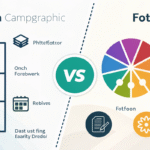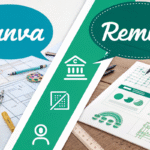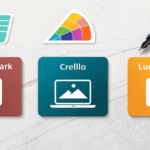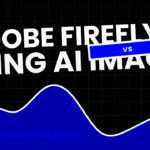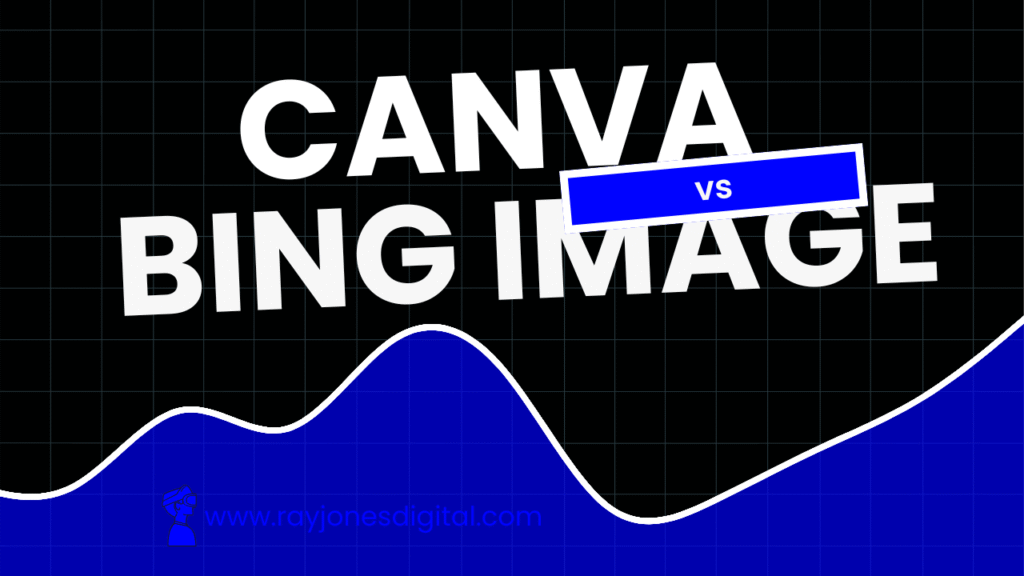
Choosing the right image creation tool can make or break your visual content strategy. With artificial intelligence reshaping how we create graphics, two platforms Canva vs Bing Image Creator have emerged as frontrunners: Canva, the established design darling, and Bing Image Creator, Microsoft’s AI-powered newcomer.
Both tools promise to transform your creative workflow, but they take vastly different approaches. Canva offers a comprehensive design suite with templates and editing tools, while Bing Image Creator harnesses AI to generate images from simple text prompts. Understanding their strengths and limitations will help you select the platform that best serves your creative needs.
What is Canva?
Canva revolutionised graphic design by making professional-quality visuals accessible to everyone. Launched in 2013, this web-based platform offers thousands of templates, stock photos, fonts, and design elements that users can customise through an intuitive drag-and-drop interface.
The platform caters to various design needs, from social media posts and presentations to logos and marketing materials. Canva’s strength lies in its user-friendly approach—no design experience required. Users simply select a template, swap out elements, and customise colours and text to create polished graphics.
Recent updates have introduced AI-powered features, including background removal, text-to-image generation, and automated design suggestions. These additions position Canva as both a traditional design tool and an AI-enhanced creative platform.
What is Bing Image Creator?
Bing Image Creator represents Microsoft’s entry into AI-generated imagery. Built on OpenAI’s DALL-E technology, this tool creates original images from text descriptions. Users input detailed prompts describing their desired image, and the AI generates multiple visual options within seconds.
The platform integrates seamlessly with Microsoft’s ecosystem, including Edge browser and Copilot. This integration allows users to generate images directly within their existing workflows, whether they’re creating presentations in PowerPoint or drafting documents in Word.
Bing Image Creator excels at producing unique, customised visuals that would be difficult or expensive to create through traditional photography or illustration. The AI can combine concepts, styles, and elements in ways that spark creative possibilities.
Key Features Comparison
Design Capabilities
Canva provides extensive design flexibility through its template library and editing tools. Users can create multi-page documents, adjust layouts precisely, and combine various design elements. The platform supports brand kits, allowing businesses to maintain consistent visual identity across all materials.
Bing Image Creator focuses purely on image generation. While it cannot create layouts or multi-element designs, it excels at producing specific visuals based on detailed descriptions. The AI can generate images in various artistic styles, from photorealistic to abstract.
Template Library
Canva’s massive template collection covers virtually every design need. From Instagram stories to business cards, users can find professionally designed starting points. These templates are regularly updated to reflect current design trends and seasonal themes.
Bing Image Creator doesn’t use templates in the traditional sense. Instead, users can reference existing art styles, photography techniques, or visual aesthetics in their prompts to guide the AI’s output.
Customisation Options
Canva offers granular control over design elements. Users can adjust colours, fonts, spacing, and positioning with precision. The platform also provides advanced features like transparency effects, shadows, and custom colour palettes.
Bing Image Creator’s customisation happens through prompt engineering. Users must describe their desired modifications in text, which requires practice to master. While this approach offers creative freedom, it lacks the precise control that traditional design tools provide.
AI Features
Canva’s AI tools enhance the traditional design process. Magic Resize automatically adapts designs for different platforms, while the AI presenter creates slideshow presentations from simple prompts. The platform’s text-to-image feature generates backgrounds and elements to complement existing designs.
Bing Image Creator is entirely AI-driven. The platform’s strength lies in its ability to understand complex prompts and generate corresponding visuals. Recent updates have improved the AI’s ability to render text within images and maintain consistency across multiple generations.
Pricing and Plans
Canva Pricing
Canva offers three main pricing tiers:
Free Plan: Includes basic templates, stock photos, and design tools. Users can create unlimited designs but have limited access to premium elements and features.
Pro Plan: £10.99 per month for individuals, unlocking premium templates, advanced AI features, brand kits, and unlimited storage.
Teams Plan: £12.99 per user per month, adding collaboration tools, team management, and approval workflows.
Bing Image Creator Pricing
Bing Image Creator operates on a credit system:
Free Access: Users receive daily credits for image generation. These credits refresh regularly, allowing consistent free usage.
Premium Access: Available through Microsoft Copilot Pro (£19 per month), which includes faster generation, more credits, and priority access during peak times.
The cost difference is significant. Canva’s subscription model provides unlimited access to design tools, while Bing Image Creator’s free tier offers substantial value for users with moderate image generation needs.
Ease of Use
Canva User Experience
Canva’s interface prioritises simplicity without sacrificing functionality. New users can create professional-looking designs within minutes, thanks to intuitive controls and helpful tutorials. The platform’s search function makes finding specific templates or elements straightforward.
The learning curve is gentle, with most features accessible through clear menus and toolbars. Advanced users can access more sophisticated tools without overwhelming beginners.
Bing Image Creator User Experience
Bing Image Creator’s interface is refreshingly simple—users type their prompt and wait for results. However, this simplicity masks the complexity of crafting effective prompts. Generating desired results often requires multiple attempts and prompt refinements.
The platform provides example prompts and style suggestions to help users get started. Once users understand prompt structure, the tool becomes remarkably powerful for creating specific imagery.
Output Quality
Canva Output
Canva produces consistently professional results across all design types. The platform’s templates ensure good composition and colour harmony, while high-quality stock assets elevate the final output. Users can export designs in various formats and resolutions suitable for both digital and print applications.
Recent AI improvements have enhanced the platform’s ability to generate cohesive designs and suggest relevant elements. However, the quality ultimately depends on the user’s design choices and template selection.
Bing Image Creator Output
Bing Image Creator’s output quality varies significantly based on prompt complexity and artistic style. Simple prompts often produce excellent results, while complex scenes with multiple elements may show inconsistencies or artifacts.
The AI excels at creating atmospheric images, artistic interpretations, and unique concepts. However, it struggles with precise technical drawings, specific product shots, or images requiring exact specifications.
Use Cases and Applications
When to Choose Canva
Canva serves users who need comprehensive design solutions:
- Small businesses creating marketing materials, social media content, and presentations
- Content creators producing consistent visual branding across platforms
- Teams requiring collaborative design workflows and brand management
- Educators developing teaching materials and student presentations
- Events and organisations needing print materials like flyers, posters, and invitations
When to Choose Bing Image Creator
Bing Image Creator benefits users seeking unique visual content:
- Bloggers and writers needing original illustrations for articles
- Social media managers creating eye-catching, unique visuals
- Concept artists exploring ideas and visual directions
- Marketers generating diverse imagery for campaigns and testing
- Developers creating placeholder images or game assets
Limitations and Considerations
Canva Limitations
Canva’s template-based approach can lead to similar-looking designs across users. The platform’s AI features, while improving, still lag behind dedicated AI image generators in terms of creativity and uniqueness.
Advanced designers might find Canva’s tools limiting compared to professional software like Adobe Creative Suite. The platform also requires an internet connection for full functionality.
Bing Image Creator Limitations
Bing Image Creator cannot produce layouts, text-heavy designs, or multi-element compositions. Users must have clear vision and strong prompt-writing skills to achieve desired results consistently.
The platform’s content policies restrict certain types of imagery, and generation quality can be inconsistent. Users also have limited control over specific design elements once images are generated.
Making the Right Choice for Your Needs
Your choice between Canva and Bing Image Creator depends on your specific requirements and workflow preferences.
Choose Canva if you need a comprehensive design platform with templates, collaboration features, and consistent output quality. The platform suits users who create various types of visual content and value reliability over uniqueness.
Choose Bing Image Creator if you prioritise unique, AI-generated imagery and have the patience to master prompt engineering. The platform excels for users who need original visuals and don’t require traditional design layouts.
Many creative professionals use both tools in complementary ways—Bing Image Creator for generating unique elements and backgrounds, then Canva for incorporating these images into larger design projects.
The Future of Visual Content Creation
Both platforms represent different approaches to democratising visual creation. Canva continues expanding its AI capabilities while maintaining its user-friendly design focus. Bing Image Creator will likely improve its generation quality and expand integration with Microsoft’s productivity suite.
The choice between structured design tools and AI generation reflects broader trends in creative technology. As AI capabilities advance, we may see these approaches converge, offering users both the control of traditional design tools and the creativity of AI generation.
Consider your current needs, budget, and long-term creative goals when making your decision. Both platforms offer free tiers, making it easy to test their capabilities before committing to a subscription.

I am Ray Jones Digital
My current occupations: a Digital Marketer, Local SEO expert, Link Builder, and WordPress SEO specialist. Shopify SEO, Ecommerce Store Management, and HTML & WordPress Developer I have been practicing the above mentioned services for more than 10 years now As an SEO expert working with your ongoing projects.
